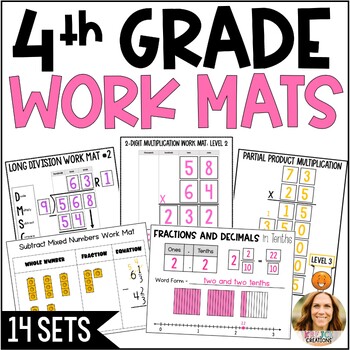4th Grade Math Work Mat Templates & Activity Mats Bundle - Interactive Notebooks
- Zip
What educators are saying
Products in this Bundle (14)
showing 1-5 of 14 products
Description
These work mats will help your students learn important 4th grade math skills in a conceptual way. They are ideal to use during whole group instruction but can also be used in small group math centers as additional support.
Work mats can be placed in sheet protectors or interactive notebooks, making them extremely versatile! They are a great supplemental resource to any 4th grade math curriculum and can also be used to accommodate students with learning difficulties.
Skills include:
✅ Rounding Whole Numbers (activity mat)
✅ 1-Digit Multiplication Strategies (up to 4 digits)
✅ 2 by 2 Digit Multiplication (area model, partial products, standard algorithm)
✅ 3 by 2 Digit Multiplication (standard algorithm)
✅ Long Division (standard algorithm)
✅ Long Division (box method)
✅ Factors, Multiples, and Prime & Composite Numbers (activity mat)
✅ Multiples of Fractions (activity mat)
✅ Subtracting Mixed Numbers with Renaming (includes a practice worksheet)
✅ Fractions and Decimals
✅ Relating Angles, Degrees, and Fractions of a Circle
✅ Area and Perimeter (includes activity mat)
Since I place all of my work mats in sheet protectors, I store them in binders, which I have for each chapter. This makes storing and finding work mats in the future super easy!
Teachers who used these work mats have said:
⭐⭐⭐⭐⭐Easy to use, easy to differentiate for different students, and they look great! I copy the mats I want to use onto cardstock, stick them in dry erase sleeves, and then students can use as needed. Some will rotate the work mats throughout the year if they still feel like they need the support so I don't have to remind them of the algorithm and they can work more independently. –Lauren H
⭐⭐⭐⭐⭐This resource is extremely helpful when teaching long division! I continue to use it during small group instruction with students who need extra support. - Lisa
⭐⭐⭐⭐⭐EXCELLENT RESOURCE! I was a bit nervous beginning subtracting mixed numbers with regrouping, but with this page, my students were able to see the process and understand why we regrouped and the result of the regrouping. We used this for notes introducing the topic, and I don't think I have ever had as many students so successful on the introduction of this standard! - Sherry
Let's Connect!
✨Blog
Copyright © Krejci Creations
This purchase is for single-classroom use only.
Please purchase additional licenses if you intend to share this product.
Be sure to leave feedback to earn points toward future purchases!





